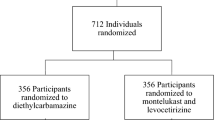Abstract
Background
Recent studies have reported that blocking IgE has a potentially beneficial role in the treatment of various allergic diseases. Previously, we found that PG102, a water-soluble extract prepared from the edible fruits of Actinidia arguta, can effectively reduce IgE levels using murine models.
Aims
To evaluate the efficacy of PG102 at lowering levels of total IgE in asymptomatic subjects with atopy.
Methods
A total of 90 asymptomatic subjects with atopy were randomized equally to a PG102 group or a placebo control group and treated for 8 weeks in a double-blind manner. Total serum IgE, eosinophilic cation protein (ECP), eotaxin, thymus, and activation-regulated chemokine (TARC), IL-4, IL-5, and IL-13 levels were measured. Eosinophil counts were determined before and after treatment, and results were compared. In addition, possible adverse reactions were thoroughly checked in this first human trial.
Results
Levels of total IgE significantly increased in the control group but showed no change in the PG102 group, and change differences between the control and PG102 groups were significant (+12.9%, vs.−5.7%, p = 0.015). Levels of ECP and eotaxin and eosinophil counts produced similar results. However, the other variables showed no significant changes after treatment.
Conclusion
In this exploratory clinical trial, it was found that 8 weeks of treatment with PG102 effectively reduced the levels of total IgE in apparently asymptomatic subjects with atopy.

Similar content being viewed by others
References
Sutton BJ, Gould HJ (1993) The human IgE network. Nature 366:421–428
Holgate S, Buhl R, Bousquet J, Smith N, Panahloo Z, Jimenez P (2009) The use of omalizumab in the treatment of severe allergic asthma: a clinical experience update. Respir Med 103:1098–1113
Casale TB, Condemi J, LaForce C, Nayak A, Rowe M, Watrous M, McAlary M, Fowler-Taylor A, Racine A, Gupta N, Fick R, Della Cioppa G, OmalizumabSeasonalAllergicRhinitisTrail Group (2001) Effect of omalizumab on symptoms of seasonal allergic rhinitis: a randomized controlled trial. JAMA 286:2956–2967
Kaplan AP, Joseph K, Maykut RJ, Geba GP, Zeldin RK (2008) Treatment of chronic autoimmune urticaria with omalizumab. J Allergy Clin Immunol 122:569–573
Lane JE, Cheyney JM, Lane TN, Kent DE, Cohen DJ (2006) Treatment of recalcitrant atopic dermatitis with omalizumab. J Am Acad Dermatol 54:68–72
Park EJ, Kim B, Eo H, Park K, Kim Y, Lee HJ, Son M, Chang YS, Cho SH, Kim S, Jin M (2005) Control of IgE and selective T(H)1 and T(H)2 cytokines by PG102 isolated from Actinidia arguta. J Allergy Clin Immunol 116:1151–1157
Kim D, Kim SH, Park EJ, Kang CY, Cho SH, Kim S (2009) Anti-allergic effects of PG102, a water-soluble extract prepared from Actinidia arguta, in a murine ovalbumin-induced asthma model. Clin Exp Allergy 39:280–289
Park EJ, Park KC, Eo H, Seo J, Son M, Kim KH, Chang YS, Cho SH, Min KU, Jin M, Kim S (2007) Suppression of spontaneous dermatitis in NC/Nga murine model by PG102 isolated from Actinidia arguta. J Invest Dermatol 127:1154–1160
Kim D, Kim SH, Park EJ, Kim J, Cho SH, Kagawa J, Arai N, Jun K, Kiyono H, Kim S (2009) Suppression of Allergic Diarrhea in Murine ovalbumin-induced Allergic Diarrhea Model by PG102, a water-soluble extract prepared from Actinidia arguta. Int Arch Allergy Immunol 150:164–171
Kim YK, Park HS, Kim HY, Jee YK, Son JW, Bae JM, Lee MH, Cho SH, Min KU, Kim YY (2001) Citrus red mite (Panonychus citri) may be an important allergen in the development of asthma among exposed children. Clin Exp Allergy 31:582–589
Gillissen A (2007) Patients’ adherence in asthma. J Physiol Pharmacol 58 Suppl 5(Pt 1): 233-241
Yang SH, Hong CY, Yu CL (2001) Decreased serum IgE level, decreased IFN-gamma and IL-5 but increased IL-10 production, and suppressed cyclooxygenase 2 mRNA expression in patients with perennial allergic rhinitis after treatment with a new mixed formula of Chinese herbs. Int Immunopharmacol 1:1173–1182
Guignard S, Arienti H, Freyre L, Lujan H, Rubinstein H (2000) Prevalence of enteroparasites in a residence for children in the Córdoba Province, Argentina. Eur J Epidemiol 16:287–293
Omenaas E, Bakke P, Elsayed S, Hanoa R, Gulsvik A (1994) Total and specific serum IgE levels in adults: relationship to sex, age and environmental factors. Clin Exp Allergy 24:530–539
Yunginger JW, Gleich GJ (1973) Seasonal changes in IgE antibodies and their relationship to IgG antibodies during immunotherapy for ragweed hay fever. J Clin Invest 52:1268–1275
Corne JM, Linaker CH, Howarth PH, Lau LC, Merrett T, Beasely R, Church M (1998) Effect of systemic beta-agonist therapy on IgE production in allergic subjects in vivo. J Allergy Clin Immunol 102:727–731
Gould HJ, Sutton BJ (2008) IgE in allergy and asthma today. Nat Rev Immunol 8:205–217
Acknowledgments
This study was supported by a grant of the Korean Health 21 R&D Projects, Ministry of Health, Welfare and Family Affairs, R.O.K. (A060655).
Conflict of interest
The authors have no conflict of interest to declare.
Author information
Authors and Affiliations
Corresponding author
Additional information
S.-H. Kim and S. Kim have equally contributed to this study.
Rights and permissions
About this article
Cite this article
Kim, SH., Kim, S., Lee, SH. et al. The effects of PG102, a water-soluble extract from Actinidia arguta, on serum total IgE levels: a double-blind, randomized, placebo-controlled exploratory clinical study. Eur J Nutr 50, 523–529 (2011). https://doi.org/10.1007/s00394-010-0159-y
Received:
Accepted:
Published:
Issue Date:
DOI: https://doi.org/10.1007/s00394-010-0159-y




